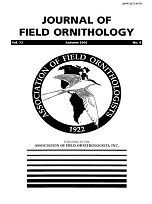Few data are available on seasonal changes in winter diet of Harlequin Ducks (Histrionicus histrionicus), especially in relation to their use of Pacific herring (Clupea pallasi) spawn. We used fecal analyses to determine seasonal changes in Harlequin Duck winter diet at a site where Pacific herring spawn. We measured frequency of occurrence and relative abundance by volume of prey remains in 202 fecal samples collected during four date periods in 1998 and 1999. These two measures were highly correlated. We identified snails, crabs, limpets, and chitons as the principal animal prey, and ranked relative importance of most prey types in similar order as previous studies using stomach analyses. Crabs parts constituted the majority of prey remains during molt, and we concluded that crabs were dominant in the diet during molt because crabs generally have greater organic content and less hard-part remains per unit of body mass than other hard-shelled prey consumed at that time. Snail remains were highest in frequency of occurrence during winter. Herring eggs were not detected in feces until a week after herring spawned, but abrupt changes in other prey types indicated that herring eggs were the principal prey throughout the spawn period. Polychaetes increased in importance in winter and spring, and rated third in frequency of occurrence in spring. We recommend using fecal analyses to determine frequency of occurrence of prey in the diet of other sea-ducks that are known to feed on hard-shelled molluscs and crustaceans. Measures of relative abundance of prey remains can be useful if conversion factors relating hard-part remains to whole-body biomass are available.
How to translate text using browser tools
1 October 2002
Use of fecal analysis to determine seasonal changes in the diet of wintering Harlequin Ducks at a herring spawning site
Michael S. Rodway,
Fred Cooke
ACCESS THE FULL ARTICLE
It is not available for individual sale.
This article is only available to subscribers.
It is not available for individual sale.
It is not available for individual sale.

Journal of Field Ornithology
Vol. 73 • No. 4
October 2002
Vol. 73 • No. 4
October 2002
diet
fecal analysis
Harlequin Duck
herring spawn
Histrionicus histrionicus
seasonal change




